# coding: utf-8
# In[1]:
import numpy as np
import pandas as pd
from matplotlib import pyplot as plt
import statsmodels.api as sm
import statsmodels.formula.api as smf
import seaborn as sns
from scipy import stats
from sklearn.cross_validation import train_test_split
get_ipython().magic('matplotlib inline')
# In[2]:
telecom_churn = pd.read_csv(r'telecom_churn.csv')
# In[3]:
telecom_churn.head()
# In[4]:
cat_cols = ['churn','posTrend','negTrend','prom','curPlan','avgplan','planChange','posPlanChange','negPlanChange']
for col in cat_cols:
telecom_churn[col] = telecom_churn[col].astype(int)
# # 两变量分析:检验该用户通话时长是否呈现出上升态势(posTrend)对流失(churn) 是否有预测价值
# In[5]:
cross1 = pd.crosstab(telecom_churn.posTrend,telecom_churn.churn, margins=True)
cross1
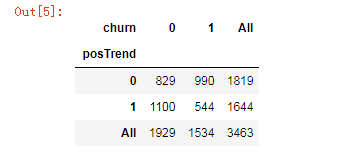
# In[6]:
def percConvert(ser):
return ser/float(ser[-1])
cross1.apply(percConvert, axis=1)
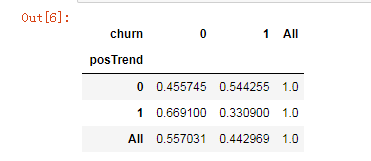
# In[7]:
cross1.apply(percConvert, axis=0)
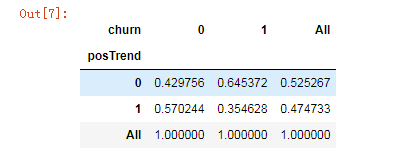
# In[8]:
cross1.iloc[:2, :2]
# In[9]:
telecom_churn.plot(x='duration', y='churn', kind='scatter')
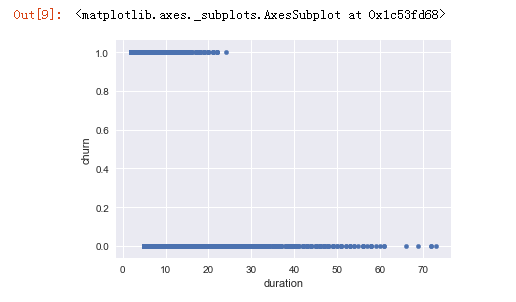
# In[10]:
print('''chisq = %6.4f
p-value = %6.4f
dof = %i
expected_freq = %s''' %stats.chi2_contingency(cross1.iloc[:2, :2]))

# # 首先将原始数据拆分为训练和测试数据集,使用训练数据集建立在网时长对流失的逻辑回归,使用测试数据集制作混淆矩阵(阈值为0.5),提供准确性、召回率指标,提供ROC曲线和AUC。
# In[11]:
X_train, X_test, y_train, y_test = train_test_split(telecom_churn.drop('churn',axis=1), telecom_churn['churn'], test_size=0.3, random_state=123)
# In[12]:
pd.concat([X_train,y_train],axis=1)
# In[13]:
lg = smf.glm('churn ~ duration', data=pd.concat([X_train,y_train],axis=1),
family=sm.families.Binomial(sm.families.links.logit)).fit()
lg.summary()

# In[14]:
X_test.head(10)
# In[15]:
X_train['churn'] = y_train
X_test['proba'] = lg.predict(X_test)
X_train['proba'] = lg.predict(X_train.drop('churn',axis=1))
X_test['churn']= y_test
X_test.head(10)
# In[16]:
X_test['prediction'] = (X_test['proba'] > 0.5).astype('int')
# In[17]:
pd.crosstab(X_test.churn, X_test.prediction, margins=True)

# In[18]:
# 准确率
acc = sum(X_test['prediction'] == X_test['churn']) /np.float(len(X_test))
print('The accurancy is %.2f' %acc)

# In[19]:
X_test.loc[(X_test['prediction'] == 1) & (X_test['churn'] == 1)]
# In[20]:
# 召回率
recall = len(X_test[(X_test['prediction'] == 1) & (X_test['churn'] == 1)]) / sum(X_test['churn'] == 1)
print('The recall is %.2f' %recall)
# In[21]:
# ROC曲线
import sklearn.metrics as metrics
fpr_test, tpr_test, th_test = metrics.roc_curve(X_test.churn, X_test.proba)
fpr_train, tpr_train, th_train = metrics.roc_curve(X_train.churn, X_train.proba)
plt.figure(figsize=[12, 12])
plt.plot(fpr_test, tpr_test, 'b--')
plt.plot(fpr_train, tpr_train, '')
plt.title('ROC curve')
plt.show()
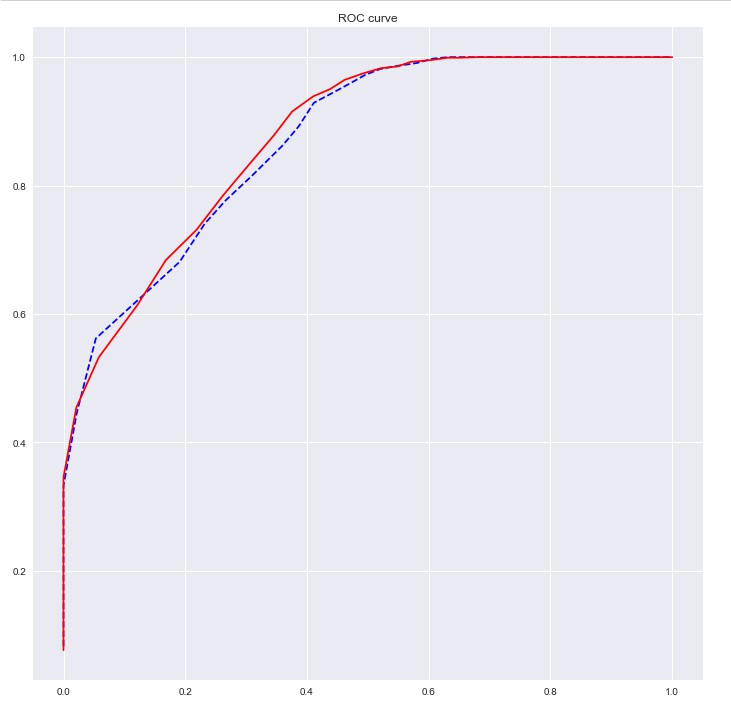
# In[22]:
print('AUC = %.4f' %metrics.auc(fpr_test, tpr_test))

# # 使用向前逐步法从其它备选变量中选择变量,构建基于AIC的最优模型,绘制ROC曲线,同时检验模型的膨胀系数
# In[23]:
# 向前法
def forward_select(data, response):
remaining = set(data.columns)
remaining.remove(response)
selected = []
current_score, best_new_score = float('inf'), float('inf')
while remaining:
aic_with_candidates=[]
for candidate in remaining:
formula = "{} ~ {}".format(
response,' + '.join(selected + [candidate]))
aic = smf.glm(
formula=formula, data=data,
family=sm.families.Binomial(sm.families.links.logit)
).fit().aic
aic_with_candidates.append((aic, candidate))
aic_with_candidates.sort(reverse=True)
best_new_score, best_candidate=aic_with_candidates.pop()
if current_score > best_new_score:
remaining.remove(best_candidate)
selected.append(best_candidate)
current_score = best_new_score
print ('aic is {},continuing!'.format(current_score))
else:
print ('forward selection over!')
break
formula = "{} ~ {} ".format(response,' + '.join(selected))
print('final formula is {}'.format(formula))
model = smf.glm(
formula=formula, data=data,
family=sm.families.Binomial(sm.families.links.logit)
).fit()
return(model)
# In[24]:
candidates = ['churn','duration','AGE','edu_class','posTrend','negTrend','nrProm','prom','curPlan','avgplan','planChange','incomeCode','feton','peakMinAv','peakMinDiff','call_10086']
data_for_select = X_train[candidates]
lg_m1 = forward_select(data=data_for_select, response='churn')
lg_m1.summary()
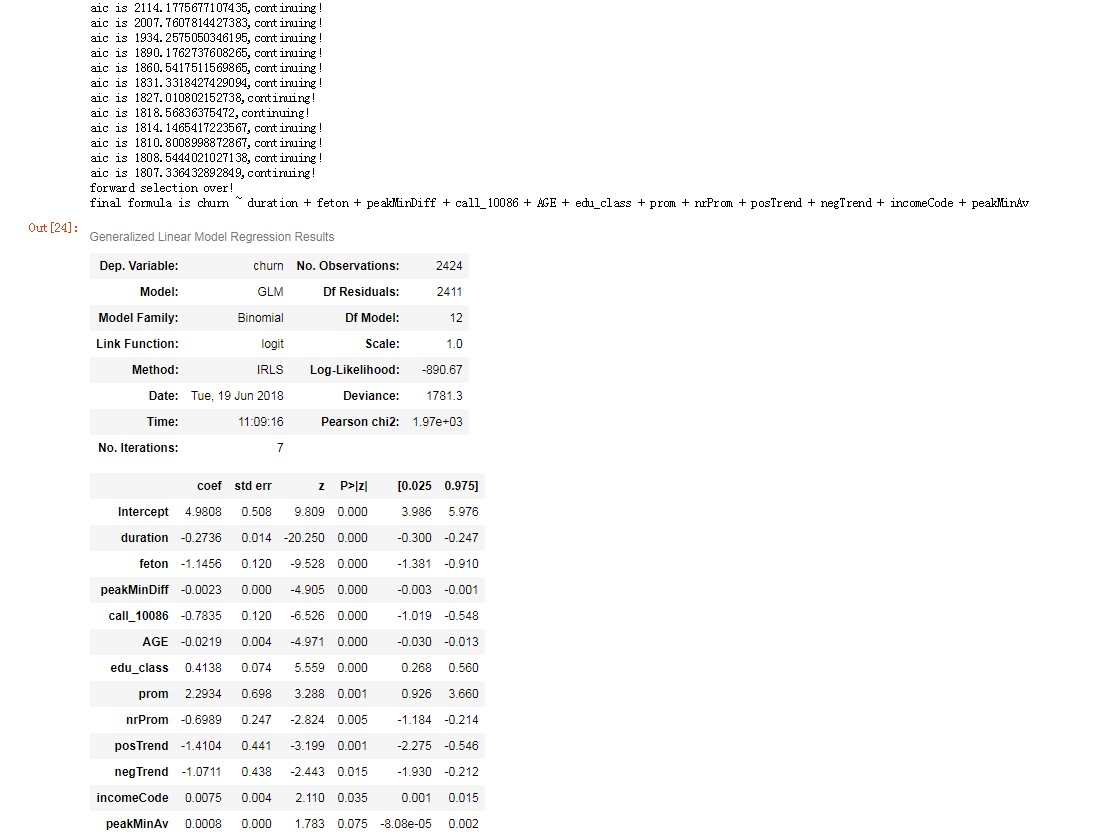
# In[25]:
def vif(df, col_i):
from statsmodels.formula.api import ols
cols = list(df.columns)
cols.remove(col_i)
cols_noti = cols
formula = col_i + '~' + '+'.join(cols_noti)
r2 = ols(formula, df).fit().rsquared
return 1. / (1. - r2)
# In[26]:
exog = X_train[candidates].drop(['churn'], axis=1)
for i in exog.columns:
print(i, '\t', vif(df=exog, col_i=i))
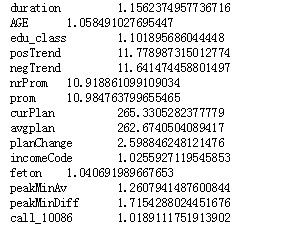
# In[27]:
lg2 = smf.glm('churn ~ duration + feton + peakMinDiff + call_10086 + AGE + edu_class + prom + nrProm + posTrend + incomeCode + peakMinAv', data=X_train.drop(['proba'],axis=1),
family=sm.families.Binomial(sm.families.links.logit)).fit()
lg2.summary()
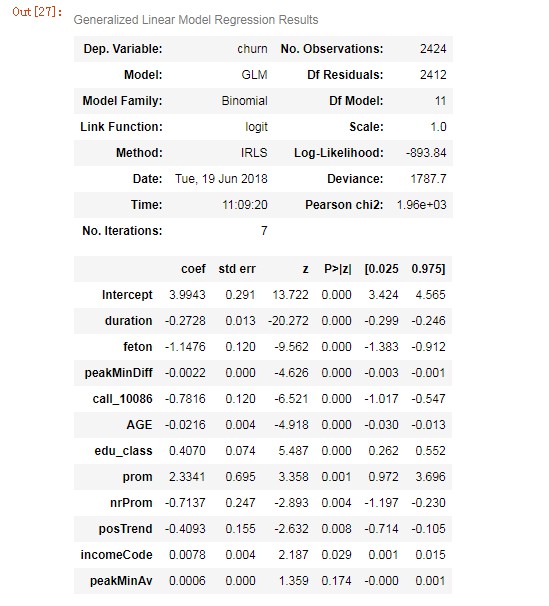
# In[28]:
# X_train.head()
X_test.head()
# In[29]:
X_train['proba2'] = lg2.predict(X_train.drop(['churn','proba'],axis=1))
X_test['proba2'] = lg2.predict(X_test.drop(['churn','proba','prediction'],axis=1))
print(X_train.head(10))
print(X_test.head(10))
# In[30]:
X_test['prediction2'] = (X_test['proba2'] > 0.5).astype('int')
# In[31]:
# 准确率
acc = sum(X_test['prediction2'] == X_test['churn']) /np.float(len(X_test))
print('The accurancy is %.2f' %acc)

# In[32]:
# 召回率
recall = len(X_test[(X_test['prediction2'] == 1) & (X_test['churn'] == 1)]) / sum(X_test['churn'] == 1)
print('The recall is %.2f' %recall)

# In[33]:
# ROC曲线
import sklearn.metrics as metrics
fpr_test, tpr_test, th_test = metrics.roc_curve(X_test.churn, X_test.proba2)
fpr_train, tpr_train, th_train = metrics.roc_curve(X_train.churn, X_train.proba2)
plt.figure(figsize=[12, 12])
plt.plot(fpr_test, tpr_test, 'b--')
plt.plot(fpr_train, tpr_train, '')
plt.title('ROC curve')
plt.show()
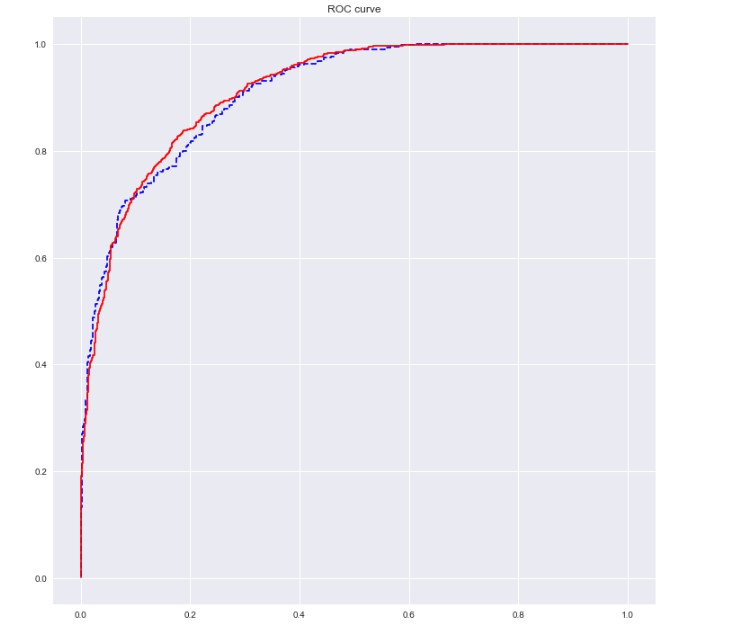
# In[34]:
print('AUC = %.4f' %metrics.auc(fpr_test, tpr_test))
